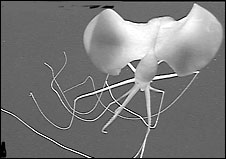Found: A Unique Squid, by any stretch
Scientists have discovered a bizarre squid deep within the world's oceans
that reaches lengths of 23 feet or more, with longer arms than those of any other known species.
More surprisingly, they say, it boasts large undulating fins
and 10 seemingly identical arms that jut outward from its body
and then bend abruptly downward, reminiscent of the spider daddy-longlegs.
Since 1988, researchers in submersibles, or mini-submarines,
have filmed the animals at least eight times in
the Gulf of Mexico and the Atlantic, Pacific and Indian oceans.
Michael Vecchione, director of the
National Oceanic & Atmospheric Administration's National
Systematic Laboratory in Washington, D.C.,
said the creature's arm arrangement is unique among known squid species.
"On a regular shallow-water squid like you'd eat for calamari,
it has eight arms that have suckers throughout," said Vecchione,
the lead author of a study appearing in today's issue of the journal Science.
Two of those tentacles are longer, with a concentration of suckers on
their ends to grab the prey and transfer it to the arms while the squid feeds.
The newly discovered creature's
"arms are very long and skinny, and they have that sort of weird elbow," Vecchione said,
an open arrangement that might avoid entangling the suspended portions.
Vecchione said scientists can only speculate about the squid's feeding habits
until a specimen is captured and studied,
but he noted that one of the observed animals stuck to a submersible and had trouble letting go.
Based on the observation, he suspects the animal's long arms act
"sort of like a living spider web," waiting to ensnare small crustaceans.
The squids, found on the ocean floor at depths up to three miles,
may be adult members of the recently identified family Magnapinnidae,
of which only juveniles have been seen previously, although Vecchione cautioned more research is needed.
"It is almost certainly a new family of squids," said Roger Hanlon of the
Marine Biological Laboratory in Woods Hole, Mass.
Return to Search of the Giant Squid

This bizarre deep-sea squid,
observed in the central Pacific from
submersibles at a depth of 3,380 meters,
was photographed in May.
Mystery denizen of the deep comes to light:
A bizarre creature with 20-foot-long spidery legs that lives in the cold,
inky black three miles below the surface of the ocean has been
discovered in photographs taken by deep-sea submersibles.
"I call it a mystery squid," said Mike Vecchione, a researcher with the
National Oceanic and Atmospheric Administration. "It's unlike any other squid I've ever seen."
Vecchione, first author of a study appearing today in the journal Science,
said the only evidence of the squid comes from photographs
and video images taken during submersible dives.
However, he said, the findings are persuasive because they came
from eight independent worldwide sightings by scientists
from eight institutions in four countries.
The sightings were in the Pacific,
Atlantic and Indian oceans and in the Gulf of Mexico.
The deepest sighting came at 15,534 feet
-- almost three miles below the surface --
in the western Atlantic off the coast of Brazil.
"Not only is this thing really bizarre, it seems to be fairly
common in deep waters all over the world," said Vecchione.
Little is known about creatures living
in the deep waters of the world's oceans, he said.
"This is the largest unexplored part of the Earth by far," said Vecchione.
"I firmly believe that there is a lot of really weird
stuff down there that we don't know about.
... We are really ignorant about what lives on our own planet"
(at great depths).
The photos show an animal with a relatively
small head topped by large fleshy, collar-like fins.
Extending from the base of the head are 10 wispy
appendages sweeping out for up to 20 feet.
Some of the appendages are sharply bent,
as if at a joint.
Some scientists reported seeing suckers
on the upper part of the limbs.
Suckers are a common feature of squid.
The largest animal sighted was about 21 feet long,
but most of that was legs and tentacles
"It is very distinctive with the
very long skinny arms, with an elbow," said Vecchione.
"There are 10 appendages there,
but they all seem to be pretty much the same.
In most squid, two would be tentacles."
The scientist said he could not estimate
the weight or mass of the animal but observed:
"It is not like a giant squid which has a really massive body.
This is a fairly small squid with bizarre arms that stretch on forever."
The deep-water home of the squid is a world of darkness,
untouched by light from the surface.
Many animals living there make
their own light with luminescent chemicals in their bodies,
but Vecchione said there was no evidence the squid could make light.
For food, Vecchione believes,
the squid may use its long arms "like a living spider web."
He said the arms appear to have a sticky
coating that could entrap small prey.
"I think it dangles those arms until
small organisms bump into them," he said. "It is like a snare."
During one Gulf of Mexico sighting,
the squid brushed against the submersible
and seemed to have problems dislodging its arms from the vessel hull.
"The arms seemed to stick to it (the vessel)
and it had trouble letting go," said Vecchione.
This suggests the arms are coated with a sticky mucous, he said.
The mystery squid cannot be named until a specimen is captured and examined,
but Vecchione said it appears similar to small squid he
and others recently discovered in shallow waters of the eastern Pacific Ocean.
Those animals have been named Magnapinnidae Pacifica, meaning "big fin."
Vecchione said the mystery squid
may be the adult form of the Magnapinnidae.
On the Net:
NOAA undersea research: www.nurp.noaa.gov
Return to Search of the Giant Squid